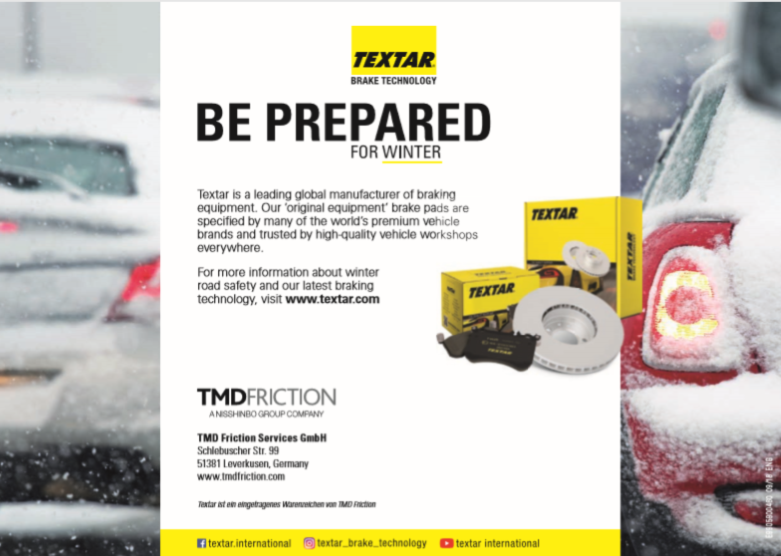Our IMI Skill Auto sponsors, Textar are there to give advise on how to tackle the winter roads.
Snow, rain, ice, wind and fog. Winter brings a host of extra challenges for motorists.
Textar is supporting workshops and the trade by preparing drivers for the winter season with a new campaign. The campaign includes a brochure and a video – with helpful pieces of advice. These include guides and tips including tyre and brake checks, and packing an emergency kit.
The video also provides helpful instructions for driving in hazardous conditions and in winter weather.
Textar is a world-leading manufacturer of brake products, so they make sure driving safety is their top priority.
- GET YOUR VEHICLE CHECKED
Bad weather will quickly expose any faults on your vehicle, so it’s very important to service, top-up, and replace all the essentials ahead of the winter months.
• BRAKES • SCREEN WASH • ANTI-FREEZE • LIGHTS • BATTERY • TYRES • FUEL-FILTER
2. CHANGE OVER TO WINTER TYRES
Winter tyres help to improve grip and control, so make sure you change over at the end of autumn. In addition, you need to keep a closer eye on tyre condition.
• CHECK TYRE PRESSURES REGULARLY • CHECK YOUR TREAD • CARRY SNOW CHAINS WHERE NECESSARY
3. UNDERSTAND YOUR ABS
When driving in slippery conditions, anti-lock braking systems (ABS) can help increase safety, but there’s a skill to using them.
• PRESS THE CLUTCH WHEN BRAKING WHILE STEERING • A RATTLING PEDAL MEANS THAT THE ROAD SURFACE IS SLIPPERY, OR THAT ABS IS ENGAGE
4. BRAKE SAFELY
Brakes are the single most important safety feature of your car. Ask your workshop for a winter brake check – and replacement if necessary. Always be aware of the impact of snow and ice on braking performance.
• LOOK AHEAD FOR HAZARDS AND AIM TO BREAK EARLY • BRAKE STEADILY AND GENTLY PUMP YOUR BRAKES • EASE OFF SOONER THAN NORMAL • ALWAYS AVOID BRAKING ON BENDS AND CORNERS • IF THE VEHICLE SWERVES OUT, STEER STRAIGHT BEFORE BRAKING • STEER INTO ANY SKID AND KEEP YOUR HANDS ON THE WHEEL • ON WET ROADS, DISENGAGE AND BRAKE LIGHTLY TO AVOID WHEEL LOCK
5. DRIVE WITH CAUTION
95% of collisions are a result of drivers not being in control. Adjust your driving style to cope with ice or snow.
SETTING OFF • ENSURE WHEELS ARE POINTING STRAIGHT AHEAD • STAY IN SECOND GEAR AND AVOID HIGH REVS
DURING THE JOURNEY
• LEAVE A FOUR SECOND GAP BETWEEN YOU AND THE VEHICLE IN FRONT • STAY IN HIGH GEAR FOR MAXIMUM CONTROL • CORNER SLOWLY • ON UNTREATED ROADS, BE WARY OF DRIVING IN WHEEL TRACKS
6. WINTER DRIVING COURSES
A winter driving course is a good idea to help you get to grips with driving in difficult and unfamiliar conditions.
• INEXPENSIVE SKID PAN COURSES HELP YOU COPE IF YOUR CAR GOES INTO A SLIDE • GENERAL WINTER DRIVING COURSES IMPROVE YOUR ALL ROUND UNDERSTANDING, HAZARD AWARENESS AND SKILLS • ONE-TO-ONE TUTORING CAN EQUIP YOU WITH EXPERT SKILLS FOR DRIVING IN TERRITORIES WHERE HEAVY SNOWFALL AND SUB-ZERO TEMPERATURES ARE THE DAILY NORM
7. TOP UP YOUR ANTI-FREEZE
LEVELS8Coolant/anti-freeze plays a vital role in cooling the engine
and preventing corrosion in your cooling system. And of course it stops your engine from freezing in all but the lowest temperatures.
• COOLANT/ANTI-FREEZE SHOULD BE CHANGED EVERY TWO YEARS, OR 50,000KM • A 50/50 MIX OF ANTI-FREEZE AND WATER IS REQUIRED FOR WINTER
8. CHECK YOUR FUEL LEVELS
Running out of fuel is one of the most common causes of breakdown. Travel disruption and extra demands on your vehicle mean you could get caught out.
• AIM FOR AT LEAST HALF A TANK FULL AT ALL TIMES • ALWAYS FILL UP WHEN YOU GET THE CHANCE • PLAN AHEAD AND SCHEDULE REFUELLING POINTS ON YOUR JOURNEY
9. PARK SENSIBLY
Your journey may be over, but your car doesn’t have to be moving to be dangerous. Think carefully about where you park.
• PARK IN A GARAGE – OR USE A BRIGHTLY COLOURED CAR COVER • AVOID DARK OR DANGEROUS LOCATIONS • IN FREEZING CONDITIONS AND WHEN ON A LEVEL SURFACE, LEAVE THE HANDBRAKE OFF TO AVOID IT FREEZING ‘ON’
10. PACK EMERGENCY EQUIPMENT
The risk of breakdown increases significantly in bad weather. So it is important to prepare for the worst and pack emergency equipment.
• BLANKET AND GLOVES • SHOVEL • DE-ICER AND SCREEN WASH • FULLY CHARGED PHONE • HIGH VIS JACKET • FIRST AID KIT • SNACKS AND HOT DRINKS • REFLECTIVE WARNING TRIANGLE
11. CARRY OUT YOUR ROUTINE VISIBILTY
Before beginning your journey, always check around your vehicle – to make sure that you have good all round visibility and that other road-users can see you.
• CLEAR SNOW/ICE FROM ALL WINDOWS AND LIGHTS • CHECK YOUR LIGHTS ARE WORKING CORRECTLY – REMEMBER TO CARRY SPARE BULBS AT ALL TIMES • IN HARSH CONDITIONS, USE YOUR DIPPED BEAMS TO PROVIDE MAXIMUM VISIBILITY
12. GET PROFFESIONAL ADVISE
Driving this winter does not have to be a daunting experience. Your local workshop or garage will have fully trained and experienced technicians who can help you avoid some of the most common winter car troubles.
• BOOK YOUR CAR IN FOR A WINTER SAFETY HEALTH CHECK • INSIST ON GOOD QUALITY REPLACEMENT PARTS, SUCH AS TYRES AND BRAKE PADS
BE PREPARED FOR WINTER
Textar is a leading global manufacturer of braking equipment. Their ‘original equipment’ brake pads are specified by many of the world’s premium vehicle brands and trusted by high-quality vehicle workshops everywhere.
For more information about winter road safety and thier latest braking technology, visit www.textar.com
TMD Friction Services GmbH Schlebuscher Str. 99 51381 Leverkusen, Germany www.tmdfriction.com




